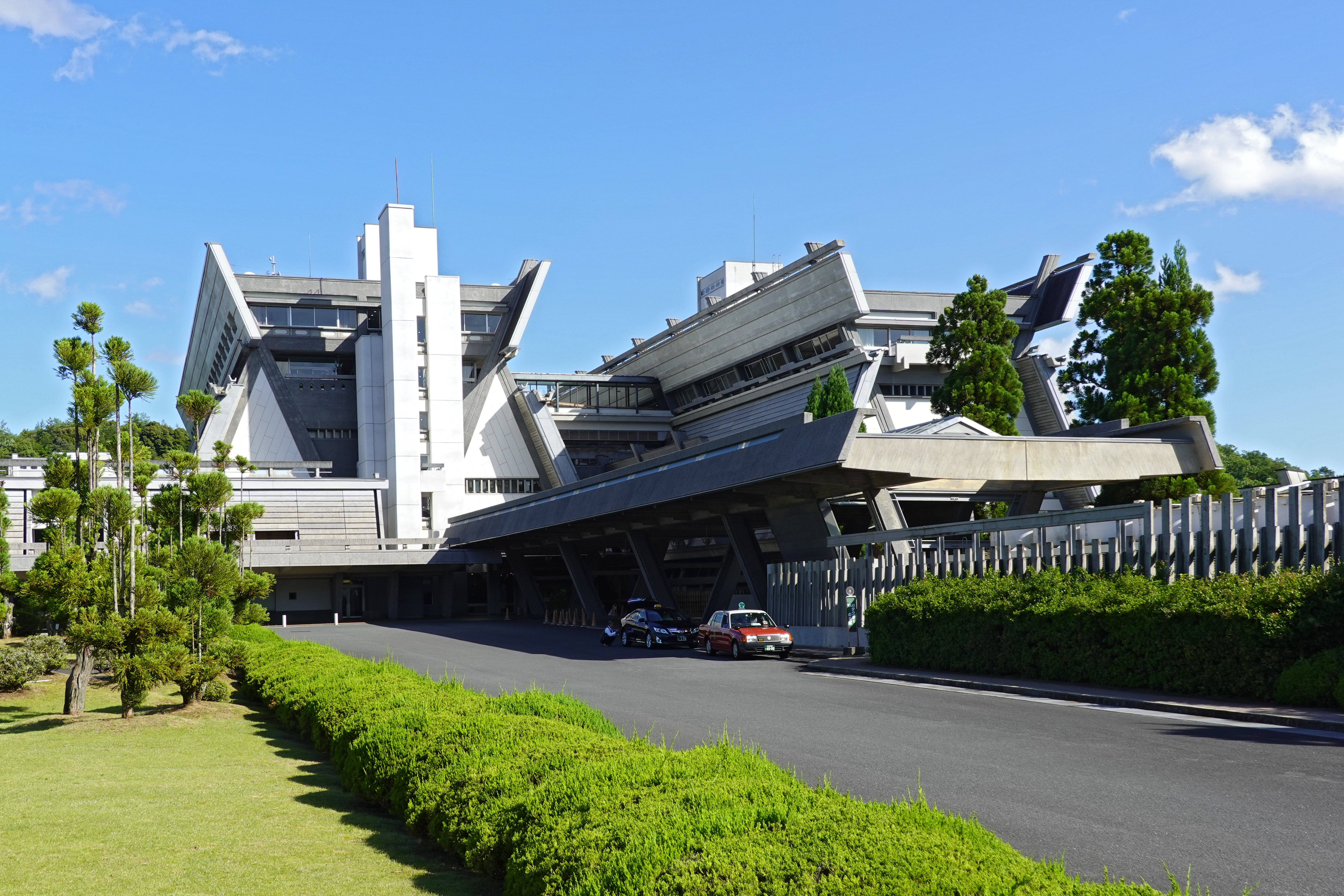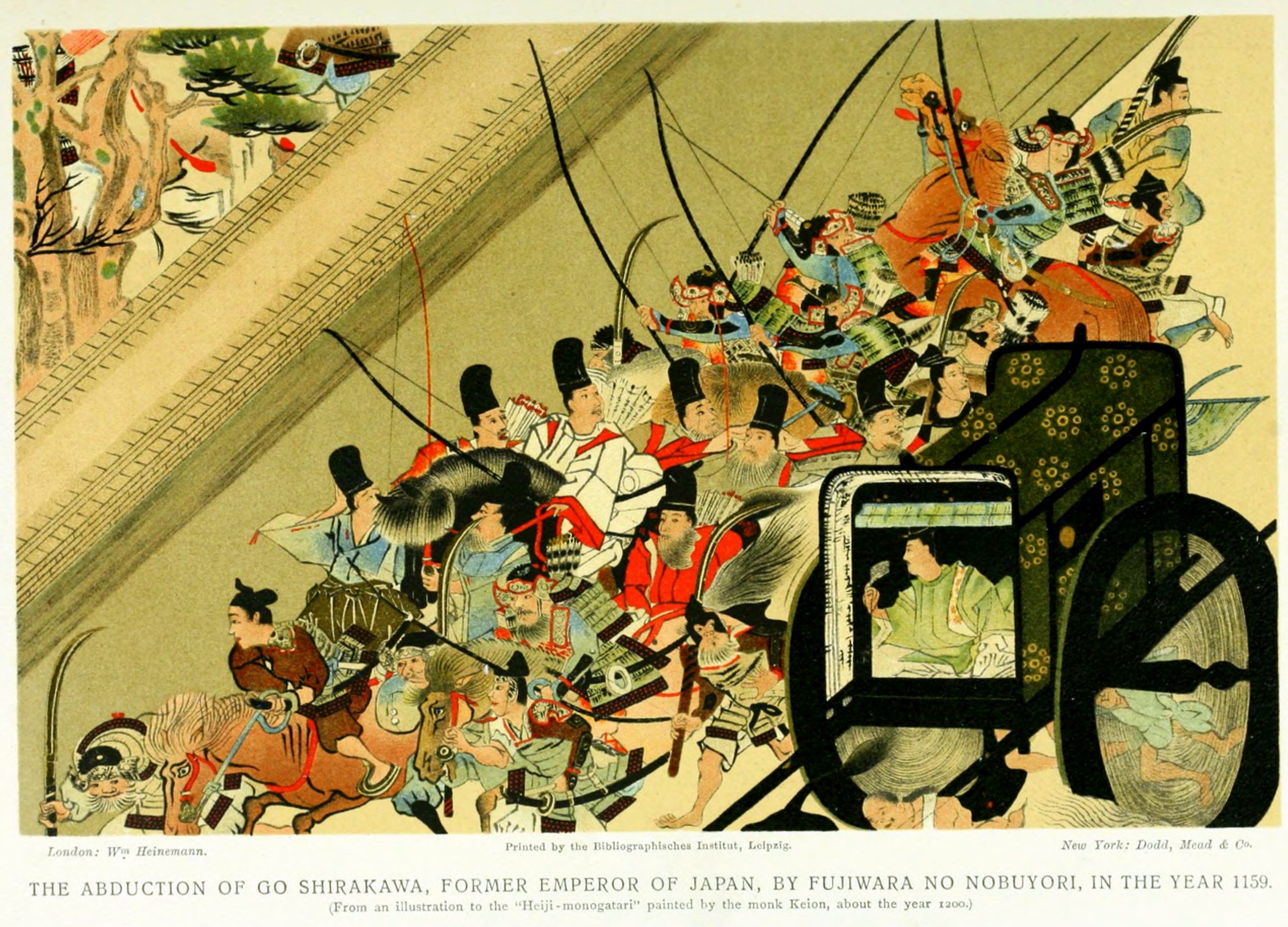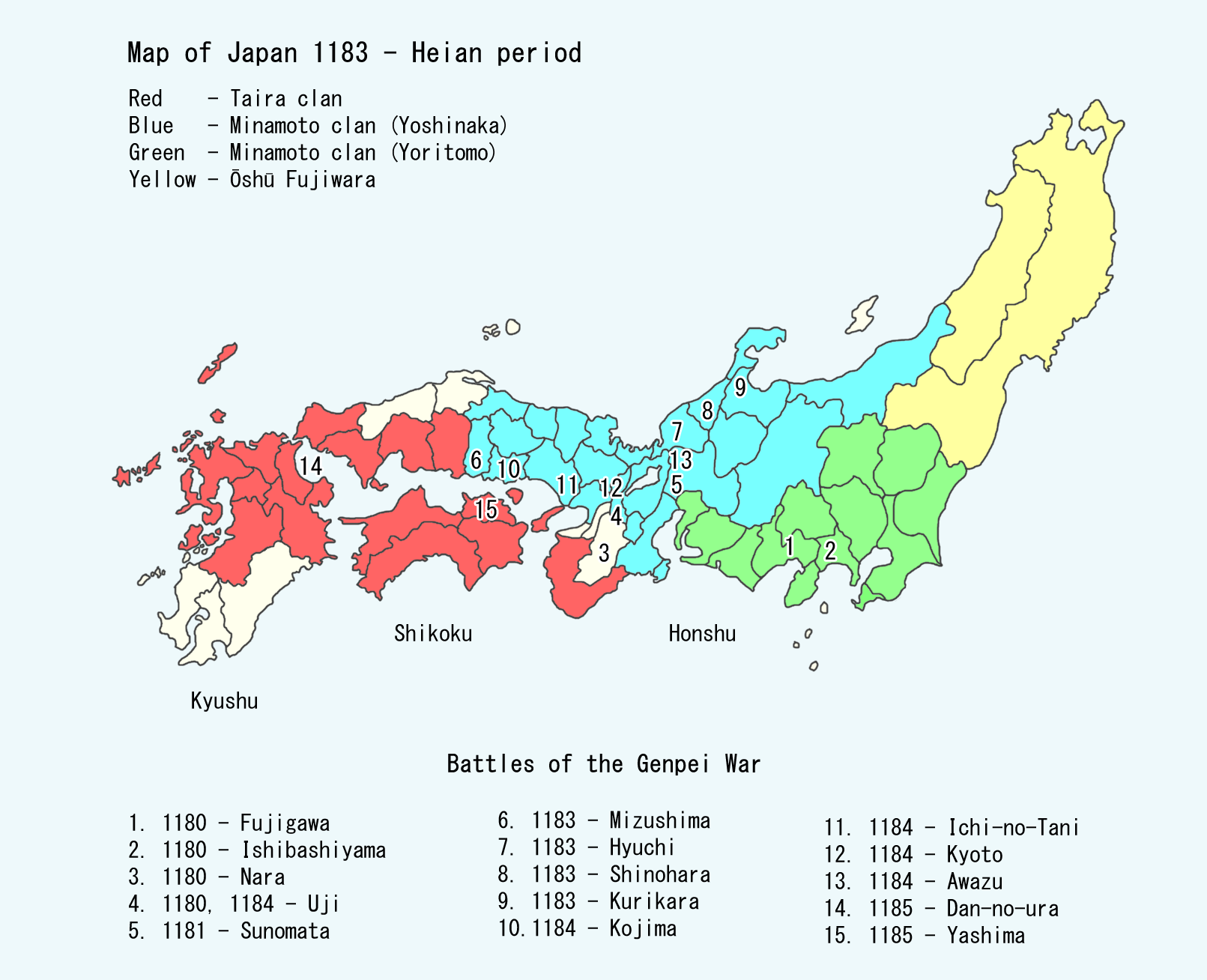|
Takeda Nobuyoshi (1128–1186)
Takeda Nobuyoshi (武田 信義, September 11, 1128 - March 31, 1186, or later than 1194) was a Japanese samurai lord of the late Heian period, Heian and early Kamakura period. He founded the Takeda clan and was the father of Ichijō Tadayori. He was also known as Takeda Tarō. Life Minamoto no Ryūkōmaru was born on September 11, 1128, the son of Minamoto no Kiyomitsu, the 3rd head of the Kai Province, Kai Minamoto clan. He was the great-grandson of Minamoto no Yoshimitsu. In 1140, at the age of 13, he held his coming of age ceremony (''genpuku'') at Takeda Hachimangū shrine, and changed his name to Takeda Tarō Nobuyoshi (Tarō being his Courtesy name, ''azana'' and Nobuyoshi being his ''imina''). In 1180, he joined the Genpei War on the side of the Minamoto clan and participated in the Battle of Uji (1180), Battle of Uji. After defeating the remaining forces of the Taira clan in Shinano Province, he progressed to Suruga Province with Minamoto no Yoritomo's forces. Durin ... [...More Info...] [...Related Items...] OR: [Wikipedia] [Google] [Baidu] |
Takeda Nobuyoshi
was a Japanese ''daimyō'' of the early Edo period. He was the son of shogun Tokugawa Ieyasu. Life Born Tokugawa Fukumatsumaru (福松丸), he was one of Tokugawa Ieyasu's sons. His mother is believed to have been Otoma, the daughter of Takeda clan retainer Akiyama Torayasu. As Ieyasu took pity on the destroyed Takeda clan, he changed his son's name to Takeda Manchiyomaru (万千代丸) and then Takeda Shichirō (七郎) Nobuyoshi. He entrusted the boy to the care of the Anayama of Kai Province. After Ieyasu's move into the Kantō region, Nobuyoshi was granted a 30,000 ''koku'' fief centered on Kogane Castle in Shimōsa Province. From Kogane he was moved to Sakura Castle, and a fief of 100,000 ''koku''. In 1600, for his service as ''rusui-yaku'' for the western enceinte of Edo Castle, Ieyasu (victorious in the wake of the Sekigahara Campaign) gave his son the 250,000 ''koku'' Mito fief. However, as Nobuyoshi had been sickly from birth, he soon died at the age of 19. With ... [...More Info...] [...Related Items...] OR: [Wikipedia] [Google] [Baidu] |
Courtesy Name
A courtesy name ( zh, s=字, p=zì, l=character), also known as a style name, is an additional name bestowed upon individuals at adulthood, complementing their given name. This tradition is prevalent in the East Asian cultural sphere, particularly in China, Japan, Korea, Taiwan and Vietnam. Courtesy names are a marker of adulthood and were historically given to men at the age of 20, and sometimes to women upon marriage. Unlike art names, which are more akin to pseudonyms or pen names, courtesy names served a formal and respectful purpose. In traditional Chinese society, using someone's given name in adulthood was considered disrespectful among peers, making courtesy names essential for formal communication and writing. Courtesy names often reflect the meaning of the given name or use homophonic characters, and were typically disyllabic after the Qin dynasty. The practice also extended to other East Asian cultures, and was sometimes adopted by Mongols and Manchu people, Manchus ... [...More Info...] [...Related Items...] OR: [Wikipedia] [Google] [Baidu] |
Tōdai-ji
is a Buddhist temple complex that was once one of the powerful Nanto Shichi Daiji, Seven Great Temples, located in the city of Nara, Nara, Nara, Japan. The construction of the temple was an attempt to imitate Chinese temples from the much-admired Tang dynasty. Though it was originally founded in the year 738 CE, Tōdai-ji was not opened until the year 752 CE. The temple has undergone several reconstructions since then, with the most significant reconstruction (that of the Great Buddha Hall) taking place in 1709. However, it was on the verge of collapse in the late 19th century due to the weight of its huge roof. The collapse was prevented through a first restoration (1904–1913), and its current appearance was completed using rebars and concretes between 1974 and 1980. Its Great Buddha Hall ( ''Daibutsuden'') houses the world's largest bronze statue of the Buddha Vairocana, known in Japanese as ''Daibutsu'' (). The temple also serves as the Japanese headquarters of the Kegon sch ... [...More Info...] [...Related Items...] OR: [Wikipedia] [Google] [Baidu] |
Kyoto
Kyoto ( or ; Japanese language, Japanese: , ''Kyōto'' ), officially , is the capital city of Kyoto Prefecture in the Kansai region of Japan's largest and most populous island of Honshu. , the city had a population of 1.46 million, making it the List of cities in Japan, ninth-most populous city in Japan. More than half (56.8%) of Kyoto Prefecture's population resides in the city. The city is the cultural anchor of the substantially larger Greater Kyoto, a metropolitan statistical area (MSA) home to a census-estimated 3.8 million people. It is also part of the even larger Keihanshin, Keihanshin metropolitan area, along with Osaka and Kobe. Kyoto is one of the oldest municipalities in Japan, having been chosen in 794 as the new seat of Japan's imperial court by Emperor Kanmu. The original city, named Heian-kyō, was arranged in accordance with traditional Chinese feng shui following the model of the ancient Chinese capitals of Chang'an and Luoyang. The emperors of Japan ruled fro ... [...More Info...] [...Related Items...] OR: [Wikipedia] [Google] [Baidu] |
Azuma Kagami
is a Japanese historical chronicle. The medieval text chronicles events of the Kamakura Shogunate from Minamoto no Yoritomo's rebellion against the Taira clan in Izokuni of 1180 to Munetaka Shinnō (the 6th shōgun) and his return to Kyoto in 1266.National Archives of JapanFeng, Wang The work is also called after the Later Hōjō family of Odawara (Kanagawa prefecture), in whose possession it used to be before it was donated to Tokugawa Ieyasu. It originally consisted of 52 chapters, but the 45th is lost. In spite of its many flaws, the document is considered the most important existing document concerning the Kamakura period. History The ''Azuma Kagami'' was compiled after 1266 under the directive of the Hōjō shikken (officially a regent to a shōgun, but the ''de facto'' ruler) and is a record in diary form of events occurring in Japan. Written in a Japanized version of classical Chinese known as , the massive work was incomprehensible to most Japanese until an edition ... [...More Info...] [...Related Items...] OR: [Wikipedia] [Google] [Baidu] |
Musashi Province
was a Provinces of Japan, province of Japan, which today comprises Tokyo, Tokyo Metropolis, most of Saitama Prefecture and part of Kanagawa Prefecture. It was sometimes called . The province encompassed Kawasaki, Kanagawa, Kawasaki and Yokohama. Musashi bordered on Kai Province, Kai, Kōzuke Province, Kōzuke, Sagami Province, Sagami, Shimōsa Province, Shimōsa, and Shimotsuke Provinces. Musashi was the largest province in the Kantō region. History Musashi had its ancient capital in modern Fuchū, Tokyo, and its provincial temple in what is now Kokubunji, Tokyo. By the Sengoku period, the main city was Edo, which became the dominant city of eastern Japan. Edo Castle was the headquarters of Tokugawa Ieyasu before the Battle of Sekigahara and became the dominant city of Japan during the Edo period, being renamed Tokyo Prefecture, Tokyo during the Meiji Restoration. Hikawa Shrine (Saitama), ''Hikawa-jinja'' was designated as the chief Shinto shrine (''ichinomiya'') of the provinc ... [...More Info...] [...Related Items...] OR: [Wikipedia] [Google] [Baidu] |
Kamakura Shogunate
The was the feudal military government of Japan during the Kamakura period from 1185 to 1333. Nussbaum, Louis-Frédéric. (2005)"''Kamakura-jidai''"in ''Japan Encyclopedia'', p. 459. The Kamakura shogunate was established by Minamoto no Yoritomo after victory in the Genpei War and appointing himself as ''shōgun''. Yoritomo governed Japan as military dictator from the eastern city of Kamakura with the emperor of Japan and his Imperial Court in the official capital city of Heian-kyō (Kyoto) as figureheads. The Kamakura ''shōguns'' were members of the Minamoto clan until 1226, the Fujiwara clan until 1252, and the last six were minor princes of the imperial family.Nussbaum"Minamoto"at pp. 632–633. The Hōjō clan were the '' de facto'' rulers of Japan as '' shikken'' (regent) of the ''shōgun'' from 1203.Nussbaum"Fujiwara"at pp. 200–201. The Kamakura shogunate saw the Jōkyū War in 1221 and the Mongol invasions of Japan under Kublai Khan in 1274 and 1281. The Kamaku ... [...More Info...] [...Related Items...] OR: [Wikipedia] [Google] [Baidu] |
Emperor Go-Shirakawa
was the 77th emperor of Japan, according to the traditional order of succession. His de jure reign spanned the years from 1155 through 1158, though arguably he effectively maintained imperial power for almost thirty-seven years through the ''insei'' system – scholars differ as to whether his rule can be truly considered part of the ''insei'' system, given that the Hōgen Rebellion undermined the imperial position. However, it is broadly acknowledged that by politically outmaneuvering his opponents, he attained greater influence and power than the diminished authority of the emperor's position during this period would otherwise allow. Posthumously, this 12th-century sovereign was named after the 11th-century Emperor Shirakawa. ''Go-'' (後), translates literally as "later"; and thus, he is sometimes called the "Later Emperor Shirakawa", or in some older sources, may be identified as "Shirakawa, the second" or as "Shirakawa II". Unusually, the years of Go-Shirakawa's reign ar ... [...More Info...] [...Related Items...] OR: [Wikipedia] [Google] [Baidu] |
Battle Of Fujigawa
The was a battle of the Genpei War of the Heian period of Japanese history. It took place in 1180, in what is now Shizuoka Prefecture. Background Minamoto no Yoritomo, using Kamakura as his headquarters, sent his counselor Hōjō Tokimasa in August 1180 to convince the warlords Takeda of Kai and Nitta of Kotsuke to follow Yoritomo's command as he marched against the Taira. As Yoritomo continued through the region below Mount Fuji and into Suruga Province, he planned a rendezvous with the Takeda clan and other families of the provinces of Kai and Kōzuke to the north. These allies arrived at the rear of the Taira army in time to ensure a Minamoto victory. Battle During the night, Yoritomo launched an attack against the large Taira army camp. The Taira became alarmed when a flock of waterfowl flew over their camp, and the "small surprise became a rout". See also * The Tale of the Heike is an epic account compiled prior to 1330 of the struggle between the Taira ... [...More Info...] [...Related Items...] OR: [Wikipedia] [Google] [Baidu] |
Minamoto No Yoritomo
was the founder and the first shogun of the Kamakura shogunate, ruling from 1192 until 1199, also the first ruling shogun in the history of Japan.Nussbaum, Louis-Frédéric. (2005). "Minamoto no Yoriie" in . He was the husband of Hōjō Masako who acted as regent (''shikken'') after his death. Yoritomo was the son of Minamoto no Yoshitomo and belonged to Seiwa Genji's prestigious Kawachi Genji family. After successfully maneuvering himself to the position of rightful heir of the Minamoto clan, he led his clan against the Taira clan, Taira from his capital in Kamakura, beginning the Genpei War in 1180. After five years of civil war, the Minamoto clan finally defeated the Taira in the Battle of Dan-no-ura in 1185. Yoritomo established the supremacy of the samurai caste and the first shogunate (''bakufu'') which was to be centered around Kamakura, thus beginning the History of Japan#Feudal Japan, feudal age in Japan, which lasted until the 17th century. Early life Yoritomo was t ... [...More Info...] [...Related Items...] OR: [Wikipedia] [Google] [Baidu] |
Shinano Province
or is an old province of Japan that is now Nagano Prefecture. Shinano bordered Echigo, Etchū, Hida, Kai, Kōzuke, Mikawa, Mino, Musashi, Suruga, and Tōtōmi Provinces. The ancient capital was located near modern-day Matsumoto, which became an important city of the province. The World War II-era Japanese aircraft carrier ''Shinano'' was named after this old province. Historical record In 713, the road that traverses Mino and Shinano provinces was widened to accommodate increasing numbers of travelers through the Kiso District of modern Nagano Prefecture. In the Sengoku period, Shinano Province was often split among fiefs and castle towns developed, including Komoro, Ina, and Ueda. Shinano was one of the major centers of Takeda Shingen's power during his wars with Uesugi Kenshin and others. During the Azuchi–Momoyama period, after Nobunaga's assassination at Honnō-ji Incident, the province was contested between Tokugawa Ieyasu and the Go-Hōjō clan ... [...More Info...] [...Related Items...] OR: [Wikipedia] [Google] [Baidu] |
Taira Clan
The was one of the four most important Japanese clans, clans that dominated Japanese politics during the Heian period, Heian period of History of Japan, Japanese history – the others being the Minamoto clan, Minamoto, the Fujiwara clan, Fujiwara, and the Tachibana clan (kuge), Tachibana. The clan is divided into four major groups, named after the Emperor of Japan, emperors they descended from: Emperor Kanmu, Kanmu Heishi, Emperor Ninmyō, Ninmyō Heishi, Emperor Montoku, Montoku Heishi, and Emperor Kōkō, Kōkō Heishi, the most influential of which was the Kanmu Heishi line. In the twilight of the Heian period, the Taira controlled the boy emperor Emperor Antoku, Antoku (himself the grandson of the powerful ''Kugyō'' Taira no Kiyomori) and had effectively dominated the Imperial capital of Heian-kyō, Heian. However, they were opposed by their rivals the Minamoto clan (the Genji), which culminated in the Genpei War (1180–1185 AD). The five-year-long war concluded with a d ... [...More Info...] [...Related Items...] OR: [Wikipedia] [Google] [Baidu] |






